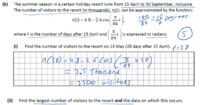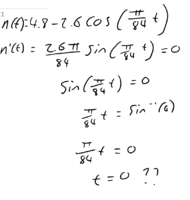You are using an out of date browser. It may not display this or other websites correctly.
You should upgrade or use an alternative browser.
You should upgrade or use an alternative browser.
Trig function - differentiate it and solve help
- Thread starter Mickof
- Start date
D
Deleted member 4993
Guest
You say:Hi,
I am trying to solve the below question but every time i differentiate it and solve for t, I keep getting 0 which is not correct. Any help please ?
Its part 2 about the largest number of visitors i cant get.
View attachment 21461
"........every time i differentiate it and solve for t, I keep getting 0......."
Please share your work with differentiation, for us to catch your mistake.
pka
Elite Member
- Joined
- Jan 29, 2005
- Messages
- 11,975
Well surely you can see by inspection that \(n'(84)=0\)? Because \(\sin(\pi)=0\)???thanks for that but I am trying to work it out without the use of a graph
Well surely you can see by inspection that \(n'(84)=0\)? Because \(\sin(\pi)=0\)???
yes i can see that but in my attempt above im trying to work out the largest numbers by differentiate function first, let = to 0 and solve for t, then sub value into original function
pka
Elite Member
- Joined
- Jan 29, 2005
- Messages
- 11,975
This is commonly called a wave. The max/min are solved by inspections.
Using either the \(\arcsin\text{ or }\arccos\) function is at best problematic because of domain/range issues.
One looks at the function in the domain \([0,175]\) the derivative is zero only for \(t=84\) by inspection.
Using either the \(\arcsin\text{ or }\arccos\) function is at best problematic because of domain/range issues.
One looks at the function in the domain \([0,175]\) the derivative is zero only for \(t=84\) by inspection.
Dr.Peterson
Elite Member
- Joined
- Nov 12, 2017
- Messages
- 16,605
You posted this under Trigonometry, not Calculus; and that is appropriate, because this kind of problem is commonly posed before students have any knowledge of calculus, and solved by knowledge of the behavior of the sine or cosine function and transformations of it. This knowledge is essentially what we mean by "inspection". In particular, solving the resulting trig function requires essentially the same kind of thinking as inspection!Any max/min problems i have solved before I have always worked them out and not by inspection though - just confusing that the above wont solve and wondering is it a mistake i am making but i appreciate your help
But given that you want to solve by calculus, you are fine as far as sin(pi/84 t) = 0. The rest is trig! You have to use your knowledge of the period of the sine; in particular, that sin(u) = 0 when u = n pi, for any integer n. So pi/84 t = n pi; you need to find the value of n for which t will be in the appropriate interval.
"So pi/84 t = n pi; you need to find the value of n for which t will be in the appropriate interval. "
May I humbly suggest in order to avoid confusion since in this problem the symbol [MATH]n[/MATH] is being used to stand for the number of visitors, that this sentence be amended to:
So [MATH](\pi/84) t = m\pi[/MATH], where [MATH]m[/MATH] is any positive integer; solve this equation for [MATH]t[/MATH] and then plug in a value of [MATH]m[/MATH] that gives you a value of [MATH]t[/MATH] in the appropriate interval.
May I humbly suggest in order to avoid confusion since in this problem the symbol [MATH]n[/MATH] is being used to stand for the number of visitors, that this sentence be amended to:
So [MATH](\pi/84) t = m\pi[/MATH], where [MATH]m[/MATH] is any positive integer; solve this equation for [MATH]t[/MATH] and then plug in a value of [MATH]m[/MATH] that gives you a value of [MATH]t[/MATH] in the appropriate interval.
Dr.Peterson
Elite Member
- Joined
- Nov 12, 2017
- Messages
- 16,605
Good point; I was looking only at the equation being solved, not the original problem."So pi/84 t = n pi; you need to find the value of n for which t will be in the appropriate interval. "
May I humbly suggest in order to avoid confusion since in this problem the symbol [MATH]n[/MATH] is being used to stand for the number of visitors, that this sentence be amended to:
So [MATH](\pi/84) t = m\pi[/MATH], where [MATH]m[/MATH] is any positive integer; solve this equation for [MATH]t[/MATH] and then plug in a value of [MATH]m[/MATH] that gives you a value of [MATH]t[/MATH] in the appropriate interval.
I would have used k if I'd noticed that.
It has to do with the fact that when the sine of an angle is zero, that angle is an integer multiple of [MATH]\pi[/MATH]. In this problem the derivative of the function, whose maximum you wish to find, happens to be the sine of an expression in [MATH]t[/MATH]. Setting the derivative equal to zero implies that the expression in the sine bracket is an integer multiple of [MATH]\pi[/MATH].
Yea so sin of 0 and sin of pi hold the same value - when I was just getting 0 when solving I was forgetting about piIt has to do with the fact that when the sine of an angle is zero, that angle is an integer multiple of [MATH]\pi[/MATH]. In this problem the derivative of the function, whose maximum you wish to find, happens to be the sine of an expression in [MATH]t[/MATH]. Setting the derivative equal to zero implies that the expression in the sine bracket is an integer multiple of [MATH]\pi[/MATH].


